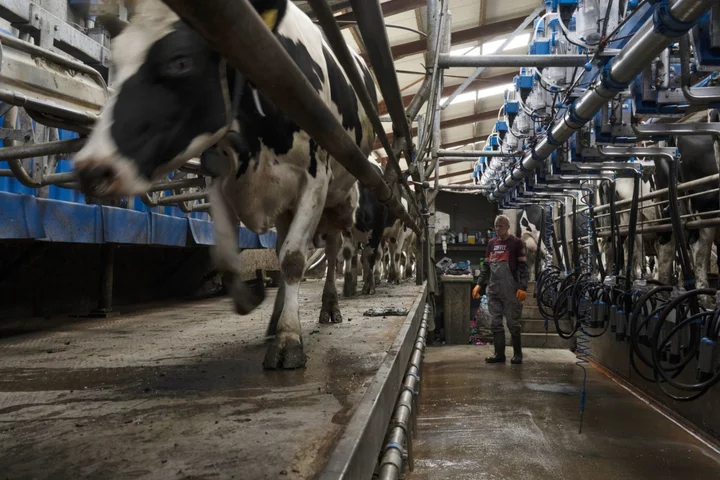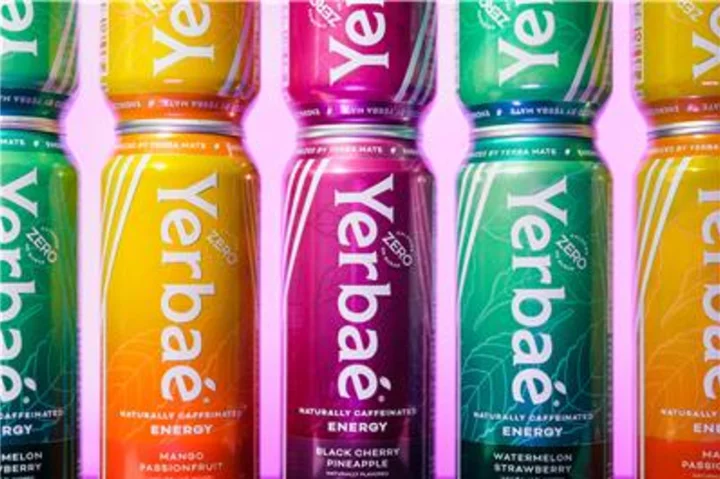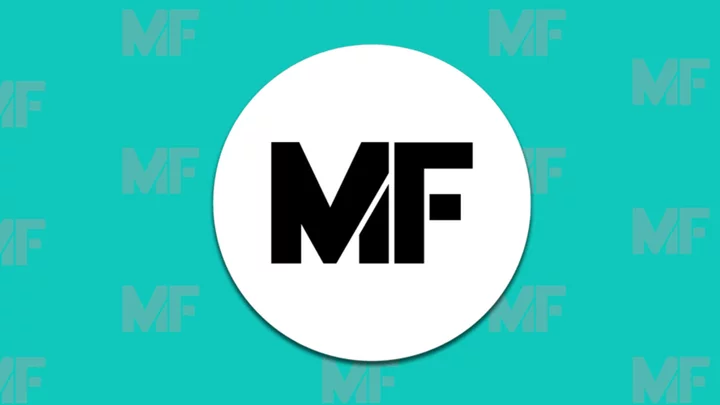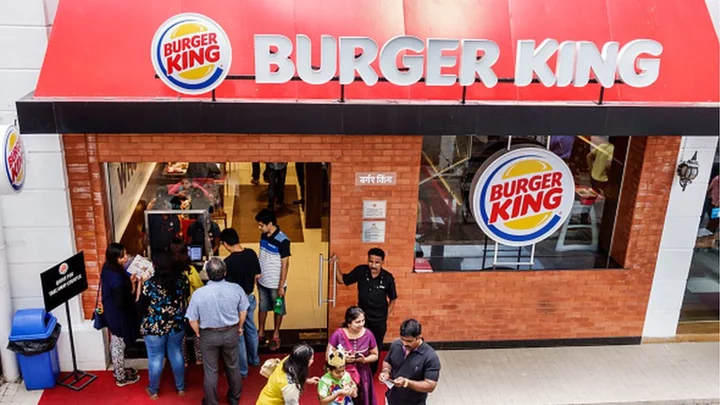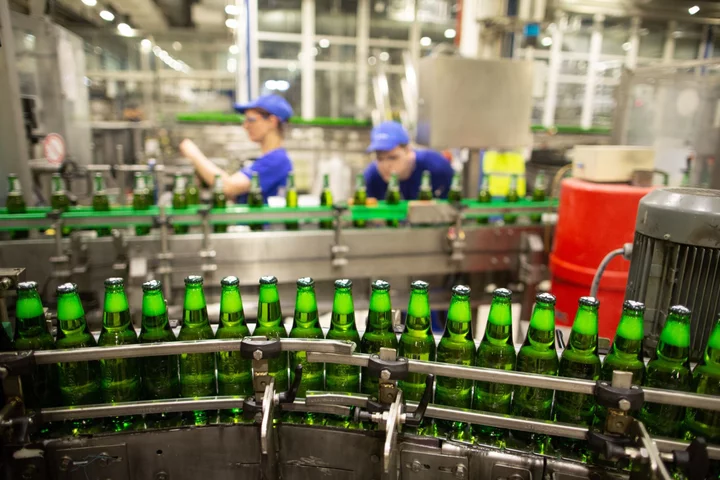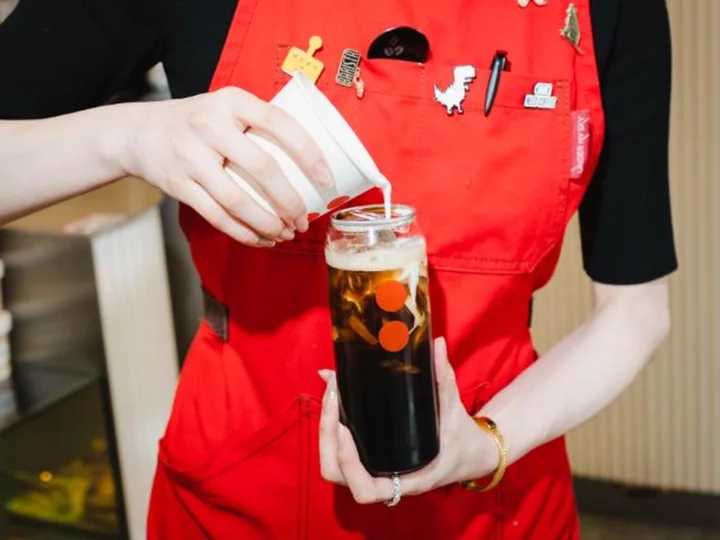Peter Hynes brimmed with impatience last winter as he mixed an off-white powder the consistency of flour into the feed for some of his cows.
The 47-year-old dairy farmer in southwest Ireland, who milks 180 cows alongside his wife and three daughters, has long been aware of his vocation’s sizable climate impact. The unique digestive systems of cows, which allow them to turn grass and other vegetation into milk, cheese and beef, also produce large quantities of methane-filled burps. These belches from cattle contribute more than 4% of the planet’s heat-trapping gases—a heftier climate impact than all the world’s airplanes.
Frustrated with the sluggish pace of climate action, Hynes reached out last year to biosciences giant DSM-Firmenich, which had just won regulatory approval for Bovaer, a feed additive that reduces the methane from cow burps by approximately 30%. No commercial farm in Ireland was using it, so Hynes became the first, paying about €600 ($660) to feed it to 20 cows over the winter. This had the same climate impact as taking one or two cars off the road for a year. Despite the hefty expense for his family farm, he plans on expanding the effort to 30 or 40 cows this winter.
“All talk and no action is going to get us nowhere,” said Hynes. “I just felt, well, it’s ridiculous that it’s not being fed in Ireland, and we just have to crack on and do it.”
While Hynes charges ahead, many of the world’s biggest buyers of dairy and beef are waiting on the sidelines. This includes corporate giants that have promised huge and rapid cuts to their greenhouse gas emissions, like Danone, Nestle, Starbucks and JBS – all of whom have publicly declared an interest in using methane-curbing feed additives with the farmers or feedlots who supply their ingredients, but have yet to follow through at any sort of magnitude.
“I’m puzzled why [Bovaer] hasn't been used on a larger scale by the industry,” said Alexander Hristov, professor of dairy nutrition at Pennsylvania State University, who has studied feed additives and their impact on methane for over two decades.
One key barrier is cost. Bovaer is priced at about 30-cents per animal per day, or about $100 per year. A typical dairy cow in Western Europe will belch the equivalent of 3.5 tons of carbon dioxide a year. That means Bovaer’s 30% reduction eliminates about 1 ton of CO2 at a cost of $100. That price would be a dream scenario for the startups pulling CO2 directly out of the air—but corporations routinely spend just $5 to $10 per ton to claim emission cuts through carbon offsets (though the impact of these credits are often dubious).
Michael Boccadoro, executive director of Dairy Cares, a coalition representing the California dairy industry, has been working for nearly two years to help develop a carbon program that would pay farmers to deploy these feed additives. “If it gets into the realm of $100 a ton, I can promise you one thing: These companies will start walking back their pledges a little bit,” he said.
In the last two years, DSM has surged ahead of a crowded field of aspirants touting feed additives as a way to slash methane emissions from cows. While many of these edible formulas—from seaweed to essential oils—remain unproven or carry potential side effects to the animals, Bovaer has emerged from dozens of peer-reviewed studies with a strong track record, according to animal scientists interviewed by Bloomberg Green.
The product works by stifling some of the chemical reactions that produce gas in the rumen of cows. Questions remain, however, about the extent to which cows will adapt to Bovaer and how well the methane improvements hold up over a year or two. Hristov, the Penn State scientist, is currently examining this question in a long-term study. But he and other scientists agree the product’s near-term methane reduction of about 30% is rock solid.
“It is genuinely market-ready,” said Richard Eckard, professor of sustainable agriculture at the University of Melbourne. “It is very effective at what it does.”
After winning its first approval from regulators in Brazil and Chile in late 2021, Bovaer was authorized for use by the EU in 2022. It’s now available in more than 45 countries, and could hit US feedlots and dairies early next year if regulators agree, according to DSM.
Despite this fast-expanding market and the planetary emergency requiring a rapid reduction in methane emissions, the product’s rollout has been tepid. Bovaer is only being fed to about 100,000 cattle worldwide, according to the company.
“I think many companies are trying to get their feet wet, trying to understand how this market works, how this fits with their systems,” said Mark van Nieuwland, DSM’s vice president for Bovaer.
Feed additives like Bovaer have long been presented as a solution that could someday ease the daunting climate math facing beef and dairy. There are 1.5 billion cows on the planet—a 62% increase since the early 1960s, according to the United Nations. That number is expected to climb as income levels rise around the world and demand for beef increases. Global food consumption (primarily methane-rich items like beef, dairy and rice) is on pace to cause one degree of additional warming by the end of the century, according to a recent paper from Columbia University.
Cutting methane is a tantalizing fix for policymakers around the world. That’s because the methane’s impact on the climate is fast and intense. Over a 20-year period, it causes 80-times more warming than an equivalent amount of CO2. But unlike CO2, which lodges in the atmosphere for centuries, a molecule of methane will break apart after about a decade. This means slashing methane emissions would almost immediately reduce its atmospheric concentrations and slow the planet’s overall rate of warming.
With this in mind, 150 countries have signed onto a Global Methane Pledge, vowing to reduce 30% of these potent emissions by 2030. With livestock the single-biggest source of methane in many countries, this is sparking tense debates. New Zealand, for instance, has infuriated cattle ranchers by proposing a tax on livestock emissions to hit the country’s climate targets, while officials in Ireland have rankled dairy farmers by considering herd reductions as a key lever to reach its own climate goals.
Cattle emissions are equally crucial for many corporate climate pledges. Nestle SA and Starbucks Corp, for instance, have both promised to halve their climate footprints by 2030. Dairy is the single largest source of emissions for each company, and they’ve both said they’re exploring feed additives as one potential solution. Neither company, though, has moved ahead with significant efforts to use these products (both companies declined interview requests). Meanwhile, they’re both struggling to reel in their climate impacts: Since the starting point of their goals, Nestle has cut emissions 1%, while Starbucks’ climate footprint has expanded 6%.
Some companies are pushing ahead with less expensive feed additives that have shakier climate benefits. Barry Callebaut, the Zurich-based chocolate maker, for instance, is chasing an ambitious goal to become “carbon positive” by 2025, meaning it will store more heat-trapping gases than it emits. Dairy is one of the company’s biggest sources of emissions, so it launched a carbon project where about 150,000 cows in the US are being fed Agolin, a mixture of essential oils including coriander seed, which purportedly cuts methane emissions by 8.4%.
But several academics say the climate claims don’t stand up. The 8.4% reduction is based on a meta-analysis of peer-reviewed papers, which isn’t included in the carbon project’s public documents. Barry Callebaut declined to share a copy of the analysis; and Verra, the nonprofit registry that oversees the carbon project, said it doesn’t have a copy.
Instead, Barry Callebaut and Agolin, the Swiss company that makes the feed additive, have both touted a different meta-analysis from 2020, which shows a similar methane reduction. But that study doesn’t provide reliable methane numbers, according to several academics, because it looked mostly at unpublished studies that have never been peer-reviewed.
“I don’t buy it, unfortunately,” said Ermias Kebreab, professor of animal science at University of California at Davis, who has studied feed additives for years. “I don’t want this to blow up in people’s faces. We need to make sure this is verifiable.”
A spokeswoman for Alltech, a Kentucky-based animal nutrition firm that recently acquired a majority interest in Agolin, defended the 2020 paper, pointing out that it included several peer-reviewed studies from “very esteemed researchers from leading universities.” Meanwhile, Frank Keidel, a spokesman for Barry Callebaut, said they’ve been conservative in their claims. “Science thrives on the clash of opinions,” he wrote in an email. “We would be surprised if all scientists were of the same opinion on these questions.”The world’s biggest meat company, meanwhile, appeared to be charting a higher-impact course. Brazil-based JBS SA vowed two years ago to spend over $1 billion as it sought to zero out all its heat-trapping emissions by 2040. “Bacon, chicken wings and steak with net zero emissions. It’s possible,” declared the company in a full-page ad in The New York Times.
That would be a staggering feat: JBS’s climate footprint is an estimated 288 million tons—equivalent to all the warming pollution from Spain—with much of it coming from the belches of cattle, according to nonprofits who tallied the figures. In late 2021, just months after its net-zero pledge, JBS Chief Executive Gilberto Tomazoni posed for cameras at a global climate conference alongside DSM’s boss and vowed to use Bovaer to lower its emissions. “Sustainability is at the core of our business strategy,” said Tomazoni.
Some 20 months later, however, JBS has gone silent on its work with Bovaer, and the company declined to publicly discuss it. Instead, JBS officials sent Bloomberg Green a statement emphasizing its various research efforts and pilot projects across the globe to cut methane from livestock, including the use of other additives like tannins and lemongrass. “JBS takes our environmental sustainability initiatives very seriously,” it stated.
Many observers remain highly skeptical. BBB National Programs, a nonprofit that promotes truth in advertising, urged the meat giant earlier this year to tone down its net-zero claims, as they don’t reflect the company’s current plans. (JBS disagrees with the findings and said it’s pursuing numerous projects to help achieve its climate targets.)
“If you’re going to talk about [feed additives], buy them and do this. Invest the money and make it a part of your emission-reduction plan,” said Nusa Urbancic, campaigns director at Changing Markets Foundation, which pressures companies on their methane emissions. “Some companies are presenting this as a silver bullet, but they’re not all that serious about scaling it up, probably because of the cost.”
If the world’s most profitable food companies are reluctant to pay for Bovaer, will anyone step up to deploy this at scale? One possibility may be Bel Group, the French cheesemaker, which produces brands like the Laughing Cow, Babybel and Boursin.
The company last year pledged to align its business with a 1.5-degree future, including a 25% reduction of its emissions by 2035. Last month, they announced they would cover the cost of Bovaer for 80% of its dairy supply in Slovakia— representing 6% of the company’s total milk purchases—by the end of the year.
That’s a significant added expense: The Bovaer-fed supply will cost about 3% more than it otherwise would, according to Simon Bonnet, Bel Group’s milk purchasing director. As of now, they don’t have plans to recoup the added cost or market the product any differently to their customers. “It’s a first move to reduce our greenhouse gas emissions at a global level,” said Bonnet.
This extra cost, though, is likely to trip up other companies that have been working with Bovaer. Dutch dairy giant FrieslandCampina, for instance, has run one of the additive’s largest trials, spanning 20,000 cows on 158 dairy farms, since March of last year.
“It’s quite an easy product,” said Sietse de Jong, who milks 250 cows on his family farm in the Netherlands and who joined the trial in September. “It’s already mixed up in the minerals you feed. You don’t see it, you don’t smell it, you don’t taste it.”
FrieslandCampina is paying for the additive during the trial, but it said it can’t afford to cover the full price after the project concludes in December. That’s because the price for Bovaer is significantly more than the premiums it can fetch for selling lower-carbon dairy products, according to Sanne Griffioen, director of sustainable farming at FrieslandCampina. “The business case is very challenging,” she said.
Instead, the dairy company will volunteer to pay half of the added cost. If dairy farmers want to keep using it, they’ll have to somehow cover the remaining bill.
It's tempting for a dairy farmer like de Jong, who has long focused on sustainability, including putting 3,000 solar panels on his premises that churn out clean electricity. But the added cost for Bovaer is much more than he can recoup on his dairy products. “There is this gap,” said de Jong. “Right now, that’s the big problem.”
--With assistance from Agnieszka de Sousa.

